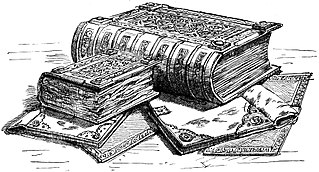
Domesday Book is a manuscript record of the Great Survey of much of England and parts of Wales completed in 1086 at the behest of King William the Conqueror. The manuscript was originally known by the Latin name Liber de Wintonia, meaning "Book of Winchester", where it was originally kept in the royal treasury. The Anglo-Saxon Chronicle states that in 1085 the king sent his agents to survey every shire in England, to list his holdings and dues owed to him.
Robert Malet was a Norman-English baron and a close advisor of Henry I.
Geoffrey de Mandeville, also known as de Magnaville, was a Constable of the Tower of London. Mandeville was a Norman, from one of several places that were known as Magna Villa in the Duchy of Normandy. These included the modern communes of Manneville-la-Goupil and Mannevillette. Some records indicate that Geoffrey de Mandeville was from Thil-Manneville, in Seine-Maritime, Haute-Normandy.
Ivo Taillebois was a powerful Norman nobleman, sheriff and tenant-in-chief in 11th-century England.

Richard William Barber is a British historian who has published several books about medieval history and literature. His book The Knight and Chivalry, about the interplay between history and literature, won the Somerset Maugham Award, a well-known British literary prize, in 1971. A similarly-themed 2004 book, The Holy Grail: Imagination and Belief, was widely praised in the UK press, and received major reviews in The New York Times and The New Republic.
Richard Scrob was a Frenchman who came to England prior to the Norman Conquest of England.
The text of Domesday Book, the record of the great survey of England completed in 1086 executed for William I of England, was first edited by Abraham Farley in the 1770s. The first facsimile edition of the manuscripts was made in a project led by the cartographer Henry James in the 1860s. An English translation of the Latin text for most counties was published by the Victoria County History (VCH) during much of the 20th century.

William de Chesney was an Anglo-Norman magnate during the reign of King Stephen of England and King Henry II of England. Chesney was part of a large family; one of his brothers became Bishop of Lincoln and another Abbot of Evesham Abbey. Stephen may have named him Sheriff of Oxfordshire. Besides his administrative offices, Chesney controlled a number of royal castles and served Stephen during some of the king's English military campaigns. Chesney's heir was his niece, Matilda, who married Henry fitzGerold.
Robert III de Stuteville was an English baron and justiciar.
The Liber Exoniensis or Exon Domesday is the oldest of the three manuscripts originating with the Domesday Survey of 1086, covering south-west England. It contains a variety of administrative materials concerning the counties of Cornwall, Devon, Dorset, Somerset and Wiltshire. It is MS 3500 in Exeter Cathedral Library.
William de Chesney was a medieval Anglo-Norman nobleman and sheriff. The son of a landholder in Norfolk, William inherited after the death of his two elder brothers. He was the founder of Sibton Abbey, as well as a benefactor of other monasteries in England. In 1157, Chesney acquired the honour of Blythburgh, and was sheriff of Norfolk and Suffolk during the 1150s and 1160s. On Chesney's death in 1174, he left three unmarried daughters as his heirs.
Roger de Pitres, a Norman, was the Sheriff of Gloucester under William the Conqueror and constable of Gloucester Castle.

The extent of the medieval district of Craven, in the north of England is a matter of debate. The name Craven is either pre-Celtic British, Britonnic or Romano-British in origin. However, its usage continued following the ascendancy of the Anglo-Saxons and the Normans – as was demonstrated by its many appearances in the Domesday Book of 1086. Places described as being In Craven in the Domesday Book fell later within the modern county of North Yorkshire, as well as neighbouring areas of West Yorkshire, Lancashire and Cumbria. Usage of Craven in the Domesday Book is, therefore, circumstantial evidence of an extinct, British or Anglo-Saxon kingdom or subnational entity.
Hugh de Montfort (Hugh II) (died 1088 or after) was a Norman nobleman. He was Lord of Montfort-sur-Risle, Constable of Normandy and a companion of William the Conqueror. Hugh's father was killed in combat with Valkelin de Ferrières in 1045.

Gamel, son of Osbern was High Sheriff of Yorkshire in 1066. He remained Sheriff of Yorkshire till 1068 and may have been the last Anglo Saxon Sheriff allowed to remain in office.
Osbern fitzRichard was a Frenchman, perhaps Norman, who was a landowner and tenant-in-chief in England. Osbern served as a royal judge and sided with the baronial rebels at the start of King William II's reign, although he later returned to the king's service.
Hugh fitzBaldric was a Norman nobleman and royal official in England after the Norman Conquest of England.

Ansgar the Staller or Esegar was one of the wealthiest and most powerful nobles in late Anglo-Saxon England. He escaped badly wounded from the Battle of Hastings in October 1066, then led the defence of London.
Reginald Arthur Welldon Finn was an English historian whose main interest was in Domesday Book. His work appeared under the names R. W. Finn, R. Welldon Finn, and Rex Welldon Finn.
Margaret de Neville, also Margaret de Longvillers and domina Margareta de Nevill was an English landowner in Yorkshire and Lancashire during the thirteenth and fourteenth centuries. Her inheritance helped to consolidate the power and influence of the House of Neville.





